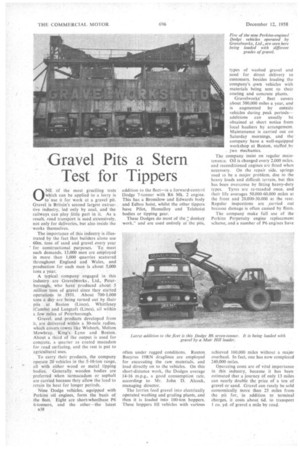Gravel Pits a Stern Test for Tippers
Page 72

If you've noticed an error in this article please click here to report it so we can fix it.
ONE of the most gruelling tests which can be applied to a lorry is to use it for work at a gravel pit. Gravel is Britain's second largest extractive industry, led only by coal, and the railways can play little part in it. As a result, road transpOrt is used extensively, not only for deliveries, but also inside the works themselves.
The importance of. this industry is illustrated by the fact that builders alone use 60m. tons of sand and gravel every year for constructional purposes. To, meet such demands, 13,000 men are employed in more than 1,000 quarries scattered throughout England and Wales, and production for each man is about 5,000 tons a year.
A typical company engaged in this industry are Gravelworks Ltd., Peterborough, who have produced about 5 million tons of gravel since they started operations in 1931. About 700-1,000 tons a day are being turned out by their pits at Baston (Lines), Whittlesey (Cambs) and Langtoft (Lines), all within a few miles of Peterborough.
Gravel, and products developed from it, are delivered within a 30-mile radius, which covers towns like Wisbech, Melton Mowbray, King's Lynn and Boston. About a third of the output is used for concrete, a quarter as coated macadam for road surfacing, and the rest is put to agricultural uses.
To carry their products, the company operate 20 vehicles in the 5-10-ton range, all with either wood or metal tipping bodies. Generally wooden bodies are preferred when tarmacadam or asphalt are carried because they allow the load to retain its heat for longer periods.
Nine Dodge vehicles, equipped with Perkins oil engines, form the basis of the fleet. Eight are short-wheelbase P6 6-tonners, and the other--the latest B38
addition to the fleet—is a forward-control Dodge 7-boner with .R6 Mk. 2 engine. This has a Bromilow and Edwards body and Edbro hoist, whilst the other tippers have Pilot, Homalloy and Telehoist bodies or tipping gear.
These Dodges do most of the :donkey work," and are used entirely at the pits,
often under rugged conditions. Ruston Bucyrus I9RN draglines are employed for excavating the raw materials, and load directly on to the vehicles. On this short-distance work, the Dodges average 14-16 m.p.g., a good consumption rate, according. to Mr. John D. Alcock, managing director.
The lorries feed gravel into electrically operated washing and grading plants, and then it is loaded into I00-ton hoppers. These hoppers fill vehicles with various
types of washed gravel and sand for direct delivery to customers, besides loading, the company's. awn vehicles with materials being sent to their coating and concrete plants.
Gravelworks' fleet covers about 500,000 miles a year, and is augmented by outside vehicles during peak periods— additions can usually be obtained at short notice from local hauliers by arrangement. Maintenance is carried out on Saturday mornings, and the company have a well-equipped workshop at Baston, staffed by Iwo thechanics.
The company. insist on regular maintenance. Oil is changed every 2,000 miles. and reconditioned engines are fitted when necessary. On the repair side, springs used to be a major problem, due to the heavy loads and difficult terrain, but this has been overcome by fitting heavy-duty types. Tyres are re-treaded once, and their life averages 50,000-60,000 miles at the front and 20,000-30,000 at the rear. Regular inspections are carried out because damage is often caused by flints.
The company make full use of the Perkins Perpetuity engine replacement scheme, and a number of P6 engines have
achieved 160,000 miles without a major overhaul. In fact, one has now completed 240,000 miles.
Operating costs are of vital importance in this industry, because it has been estimated that a journey of only 13 miles can nearly double the price of a ton of gravel or sand. Gravel can rarely be sold economically more than 25 miles from the pit for, in addition to terminal charges, it costs about 6d. to transport 1 cu. yd. of gravel a mile by road.




















































































































